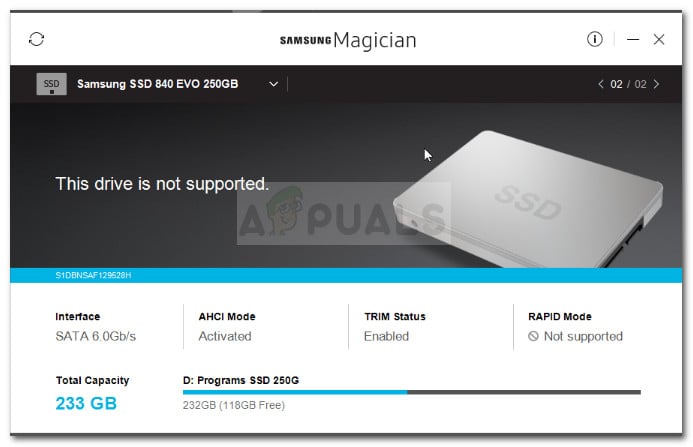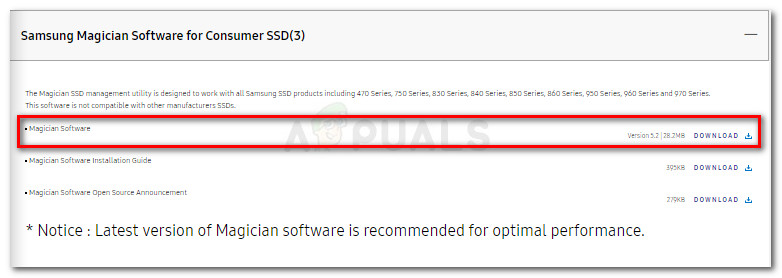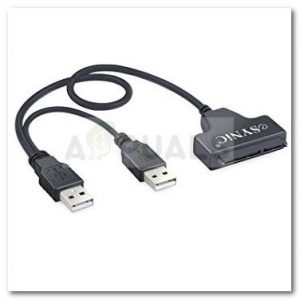Does New Samsung 850 New Firmware Upg
Some users are having trouble managing their SSDs with Samsung Sorcerer. This Samsung utility is frequently reported to turn down to recognize SSD drives even if they are mentioned in the application supported list. Near users affected by this issue report that the drive doesn’t appear at all inside Samsung Magician while Disk Management also every bit other third party utilities recognize the SSD drive.

While almost users report that there’s no error message, there are occurrences where the software sees the drive but deems it to be unsupported.
What is Samsung Magician?
Samsung Magician is a provided utility that makes information technology easier for Samsung drive owners to perform an otherwise wearisome task such as updating the firmware. On meridian of this, the software as well allows for more avant-garde modifications such equally the ability to set specific profiles according to the type of user that is using the drive.
As of at present, the software has numerous updates but most of them are specifically released to add new drives to the supported list.
What causes the Samsung Sorcerer Doesn’t recognize SSD error
After investigating the issue and looking at diverse user reports, we managed to identify a list of potential culprits that might be causing the issue:
-
Samsung Wizard is outdated
– The issue might occur if your SSD drive is not added to the supported list. If you have a brand new Samsung SSD model, Samsung Wizard utility will non recognize your drive until y’all update the awarding to the latest version. -
RAID mode is disabled
– The error is as well reported to announced if the users have RAID way enabled from the BIOS settings. In this scenario, the solution would be to access the BIOS settings, disable RAID and switch your drive configuration to AHCI. -
Samsung NVMe driver is missing from the calculator
– Sure Samsung SDD models (particularly the 950 and 960 EVO models) volition require the NVMe driver to be installed on the host computer in guild to go detected by Samsung Magician. -
SSD drive doesn’t accept enough ability to function
– This issue tin can besides be caused past a shortage of power to your SSD. This typically happens on computers using USB 3.0 to SATA adapters to make the connection. Because the SSD doesn’t accept enough power to function, it will not get detected past Samsung Magician. -
SSD is non connected through Intel controller
– Certain Samsung SSD models are reported to take connectivity consequence when connected through a different controller than Intel. This is by no means an official requirement, simply just an occurence that many users have reported.
How to fix the Samsung Magician Doesn’t recognize SSD error
If yous’re struggling to get Samsung Wizard to detect your SSD drive, this article volition help you with a list of verified troubleshooting steps. Below you take a collection of methods that other users in a similar situation have used to get get the issue resolved.
To ensure the best results, please follow the methods beneath in order that they are presented as they are ordered past efficiency and severity of changes. Permit’south begin!
Method 1: Updating the SSD commuter version via Device Manager
Let’s showtime things off by checking if Windows is able to update your drivers to a newer driver version via Device Manager. This will typically resolve the consequence if the event started occurring after the initial installation of the drive was interrupted by an unexpected event.
Here’s a quick guide on updating the SSD commuter version via Device Managing director:
- Press
Windows primal + R
to open up a Run dialog. Next, type “devmgmt.msc” and press
Enter
to open up Device Manager. If prompted by the
UAC (User Account Control), cull
Yes.

Run dialog: devmgmt.msc - Inside Device Manager, expand the drop-down bill of fare associated with Disk drives.
- Next, right-click on the SSD drive and click on
Update Driver.
Right-click on SSD drive then click on Update driver - If a new driver version is identified, follow the on-screen prompts to install it on your arrangement.
- Restart your machine and run into if the event has been resolved at the next startup.
If the issue is yet not resolved, move down to the adjacent method below.
Method two: Update Samsung Magician to the latest version
If you lot have a new drive, the consequence is most likely occurring because Samsung Wizard was not updated to add to the new list of supported drives.
If this particular scenario applies to your current situation, the solution is as simple equally updating Samsung Sorcerer to the latest version. Other users in a similar state of affairs accept reported that the issue was resolved subsequently they uninstalled Samsung Magician and installed the latest version from the manufacturer’south website. Here’s a quick guide on how to do this:
- Press
Windows cardinal + R
to open A
Run
dialog. Then, type “appwiz.cpl” and striking
Enter
to open up
Programs and Features.
Run dialog: appwiz.cpl - Within
Programs and Features, scroll downward through the application list to locate Samsung Sorcerer. - Right-click on Samsung Sorcerer and cull
Uninstall. And so, follow the on-screen prompts to remove the software from your system. - Once the software is uninstalled, restart your computer manually if you’re not prompted to practice so automatically.
- At the next startup, visit this link (
here
) and download the latest Magician Software via the button associated with it.
Download Magician software - Once the installation is complete, restart your computer again.
- At the next startup, open Samsung Magician and run into if the software manages to detect your SSD drive.
If Samsung magician is withal not recognising your SSD drive, proceed down with the next method beneath.
Method iii: Installing the NvMe Driver
For the all-time practices, Samsung recommends that you install all provided drivers (particularly the NVMe driver) before you attempt to dispense your SSD drive with Samsung Wizard.

If you don’t accept an optical drive capable of reading the provided utility DVD, y’all tin also download them from their official download page.
Yous tin can download the NVMe commuter by visiting this link (
hither
) and scrolling down to the
Download Files
page. This NVMe Driver should be compatible even if you have a different SSD model (this ane is for 960 EVO), simply just in case it isn’t, visit the specific Samsung spider web folio dedicated to your SSD model and download it from there.
Once the driver is downloaded, open the executable and follow the on-screen prompts to install the driver. When the installation is complete, reboot your reckoner and see if the issue was resolved at the next startup.
If your SSD drive is still non getting recognized by the Samsung Magician utility, continue with the next method below.
Method iv: Disabling RAID mode and switching to AHCI
As per various user reports, the issue might besides occur if your system has RAID mode enabled from the BIOS settings. Several users have reported that they managed to fix the issue past entering their BIOS settings, disabling RAID way and making the switch to AHCI.
Of class, the verbal steps of this process are specific to the motherboard manufacturer, just hither’south a quick rundown: During the initial boot, printing your BIOS cardinal repeatedly until you gain entry into BIOS settings. Yous tin search for your BIOS primal online or try any of the following ( F2, F4, F5, F8, F10, F12, Del fundamental).
In one case you’re within your BIOS
settings,
wait for an choice called
RAID or RAID Back up and set it to
Disabled. And then, look for a
SATA Mode
entry and gear up it to
AHCI. Then, salvage your changes and go out your reckoner to boot up completely and see if the issue is resolved.
Annotation:
Depending on your motherboard, you might see a
RAID
mode entry. In this case, set it to
AHCI
and save your changes.
If the procedure above didn’t enable you to alter your arrangement to AHCI, yous tin also brand the switch from RAID to AHCI via the following procedure:
Note:
This procedure will only work on Windows 10 versions.
- Press
Windows key + R
to open up up a Run dialog box. Then, blazon “cmd” and press
Ctrl + Shift + Enter
to open upwardly an elevated Command Prompt. If prompted by
UAC (User Account Control)
choose
Yes.
Run dialog: cmd then press Ctrl + Shift + Enter - Inside the elevated Control Prompt, type the post-obit command and press Enter:
bcdedit /set {current} safeboot minimalAnnotation:
If the command is not recognized, endeavour this instead:bcdedit /prepare safeboot minimal - Restart your computer and enter your BIOS setup during the next kick.
- Within your BIOS settings, change the SATA Operation style (or SATA Mode) to AHCI, save your changes and get out BIOS.
- Open another elevated Command prompt (following Step 1) and type the following control in information technology:
bcdedit /deletevalue {current} safebootNote:
If the control is not recognized, try this instead:bcdedit /deletevalue safeboot - Reboot your computer one more time. At the next startup, your computer should kick with the AHCI drivers enabled. Once the startup is complete, open Samsung Wizard and see if your SSD bulldoze is getting recognized.
If the procedures in a higher place haven’t been effective in resolving the issue, continue with the side by side method beneath.
Method 5: Checking the power requirement of your SSD
As some users have reported, there are sure Samsung SSD models that require more power than standard USB 3.0 ports are able to provide. This becomes a problem if you’re using a USB three.0 to SATA adapter to connect your SSD drive.
Considering USB three.0 ports are but capable of supplying a maximum of 0.9A and larger Samsung SSDs (such equally the 850 EVO) require at to the lowest degree 1.4A, your SSD might not get recognized because it doesn’t have enough power.
At that place’s a manner to circumvent this issue and information technology involves using a USB 3.0 adapter that has a double USB cable. This means it tin can supply 1.8A which is more than the minimum requirement.

But before you go ahead and guild yourself a double USB three.0 to SATA adapter, make sure to check power requirements of your detail SSD model to make certain that this scenario applies to your situation.
If this method wasn’t applicable, go on with the next method below.
Method 6: Connecting via Intel controller (if applicable)
Some users that encountered this issue on systems with 2 controllers (Gigabyte controller + Intel controller or Asus controller + Intel controller) accept reported that the SSD bulldoze was magically discovered by Samsung Magician when the connection is made through the Intel controller.
Nonetheless, this is simply reported to piece of work as long as your drive is fix to AHCI mode.
Method six: Using a dissimilar 3rd-party software
If all the methods presented above have been unsuccessful in assuasive you to force Samsung Magician to detect your SSD drive, there are other software that will permit you to circumvent the issue.
If you were trying to drift your Os to a unlike drive using Samsung Magician, you can use
Macrium Reflect
to attain the same thing. The free version is enough to do the job. Another great culling is to apply
AOMEI Partition Banana.

